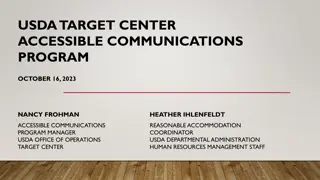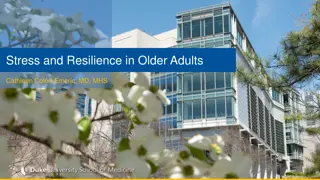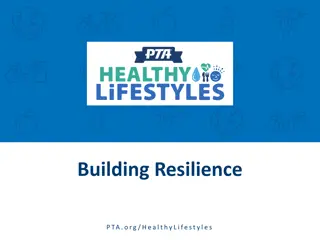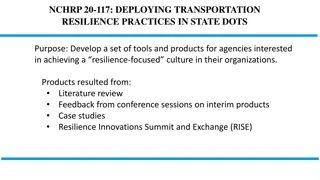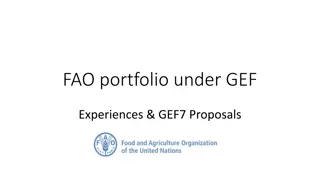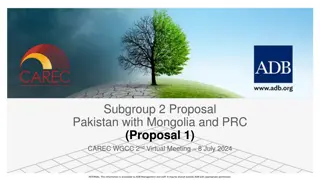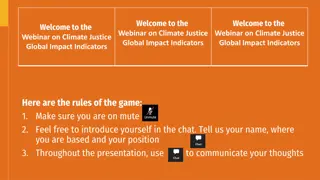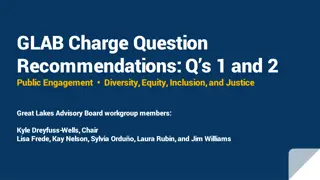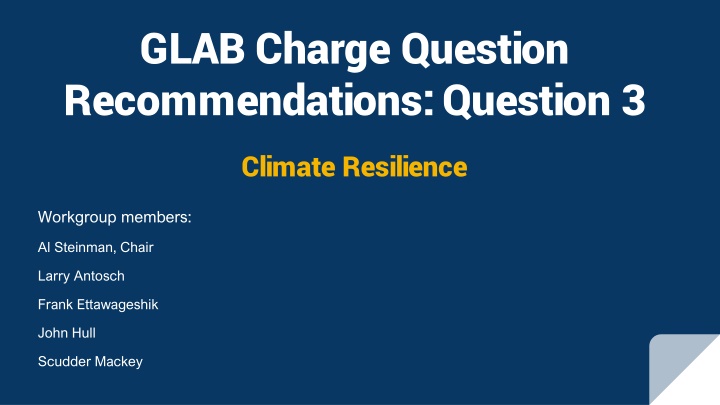
Recommendations for Enhancing Climate Resilience in GLRI APIV
The Great Lakes Advisory Board seeks input on integrating climate resilience into GLRI APIV and improving adaptation strategies. Suggestions include implementing flexible restoration approaches, considering climate impact modeling in project design, and establishing reserve funds for post-construction monitoring. Recommendations also focus on enhancing DEIJA synergies for underserved communities.
Download Presentation

Please find below an Image/Link to download the presentation.
The content on the website is provided AS IS for your information and personal use only. It may not be sold, licensed, or shared on other websites without obtaining consent from the author. If you encounter any issues during the download, it is possible that the publisher has removed the file from their server.
You are allowed to download the files provided on this website for personal or commercial use, subject to the condition that they are used lawfully. All files are the property of their respective owners.
The content on the website is provided AS IS for your information and personal use only. It may not be sold, licensed, or shared on other websites without obtaining consent from the author.
E N D
Presentation Transcript
GLAB Charge Question Recommendations: Question 3 Climate Resilience Workgroup members: Al Steinman, Chair Larry Antosch Frank Ettawageshik John Hull Scudder Mackey
Q3 - Climate Resilience in GLRI APIV EPA and the RWG would like the GLAB s input on specific examples of how climate resilience could be best incorporated into GLRI APIV. Please use GLRI APIII as a template when providing recommendations. EPA and the RWG are also interested in the Board s recommendations on how climate adaptation may be better incorporated into the GLRI s working definition of resilience.
Q3 - Climate Resilience in GLRI APIV Charge Questions Great Lakes Advisory Board to make recommendations on how climate adaptation and climate resiliency may be better incorporated into the GLRI s working definition of resilience. Modify the working definition of resilience in AP IV to implement more flexible and adaptive approaches to restoration that continue to provide functions and services in response to changing climate and other stressors. Provide specific examples of how climate could be best incorporated into GLRI AP IV, especially given the level of detail of previous action plans. Identify DEIJA synergies with climate resilience to meet the needs of underserved and IJ Communities
Q3 - Climate Resilience in GLRI APIV Outline Implementation Strategies Summary Description of Changing Climate and Great Lakes Impacts Climate Resiliency Definition and Explanation of Need New Approach to Action Plan IV * Implementation Strategies and DEIJA Interactions and Synergies Recommendations
Q3 - Climate Resilience in GLRI APIV Implementation Strategies Adopt a more flexible approach toward project implementation. GLRI grant applications should include a requirement that design, and related permit applications, include specific consideration, analysis, and modeling to address an appropriate range of potential climatological and Great Lakes level related phenomena based on current research and published updated criteria, if available. Consider project designs that identify multiple/varied BUI improvements under a range of conditions and establish flexible metrics to be monitored post- implementation. Consider an approach to determine eligible post-construction budgets for performance monitoring and adaptive management in the grant programs perhaps set up a designated, status reserve fund.
Q3 - Climate Resilience in GLRI APIV Summary Description of Changing Climate and Great Lakes Impacts Where and when possible, projects include stochastically generated time series of precipitation to examine a range of possible weather and climate conditions in the future (cf. Kwon et al. 2007, 2009). These time series can then be coupled with plausible climate trends to create a cluster of scenarios that evaluates project performance under future climate change and variability (cf. Brown et al. 2012; Whateley et al. 2014).
Q3 - Climate Resilience in GLRI APIV Climate Resiliency Definition and Explanation of Need i A. Framework for Resilient GLRI Investments Study: In 2021, the USACE, USGS, and NOAA developed a $3.2 M three-year proposal that has now been funded by Focus Area 5 to assess anticipated future changes Great Lakes weather patterns and the potential risks to the Great Lakes and investments made by the GLRI. The goal of the GLRI Framework for Resilient Investments project is to integrate the expertise of federal agencies to improve the ability to design resilient coastal projects to provide: - Forecasts of Hydrologic Uncertainty and Future Lake Levels - the range in potential high and low water elevation; - Ice Cover Analyses; - Forecasts of wave/surge intensity; - Estimates of Littoral Sediment Transport Rates; and - Coastal Change Assessment - Identifying areas susceptible to erosion and accretion.
Q3 - Climate Resilience in GLRI APIV Climate Resiliency Definition and Explanation of Need ii B. Deficiencies in Action Plan III 1. Need to Address Climate Change explicitly. - The only reference to climate change in Action Plan III is in a definition on Project Sustainability. In addition, Action Plan III s working definition of resilience suggests the intent to maintain existing conditions in the face of climate change and other stressors. The GLAB believes maintaining existing conditions is unrealistic given the dynamic nature of future weather conditions. 2. Need to Address Commitment to Adaptive Management - Innovative resilient project designs combined with a long-term commitment (resources, writ large) to adaptive management are essential components of a comprehensive resilience strategy and were not identified in GLRI Action Plan III.
Q3 - Climate Resilience in GLRI APIV New Approach to Action Plan IV (a) A. Intro on each Focus Area - Evaluated by individual focus area - Although we evaluate the five focus areas separately, the GLAB recommends that the focus areas work together to address cross-cutting issues and avoid the stovepipe syndrome. These focus area issues do not operate in isolation, both in terms of ecological impacts as well as socio-economic concerns.
Q3 - Climate Resilience in GLRI APIV New Approach to Action Plan IV (b) A. Focus Area 1: Toxics and AOCs - GLAB recommends addressing climate resilience and adaptation take place early in the early stages of a project ideally during the feasibility and design stages. - Rather than incorporating climate resiliency at the AOC level, which may be impractical, we recommend considering climate resiliency at the BUI level, which allows for more specificity. - GLAB recommends that proposals addressing chemicals of concern take into consideration an ecosystem approach, which examines not only the potential toxicity of chemicals and how they move through a system, but also how climate change can impact the kinetics (e.g., through temperature) and transit (e.g., through greater erosive power of streamflow) of these chemicals.
Q3 - Climate Resilience in GLRI APIV New Approach to Action Plan IV (c) A. Focus Area 2: Invasive Species - The GLAB recommends that models account for changes and extremes in temperature and the related impacts in DO and chemical liberation when assessing potential candidate species for invasion and the spread of existing invasives within the Great Lakes.
Q3 - Climate Resilience in GLRI APIV New Approach to Action Plan IV (d) A. Focus Area 3: Nonpoint Source Pollution Impacts on Nearshore Health Incorporate actions Action Plan IV to address climate change and address the resulting need for resiliency as a design component in activities promoted for each of the following objectives: - 3.1. Reduce nutrient loads from agricultural watersheds - 3.2. Reduce untreated stormwater runoff - 3.3. Improve effectiveness of nonpoint source control and refine management efforts Establish long-term maintenance and evaluation programs to ensure project performance longevity given the distinct probability that weather pattern changes will outpace project design (see GLAB 2022 report).
Q3 - Climate Resilience in GLRI APIV New Approach to Action Plan IV (e) A. Focus Area 3: Nonpoint Source Pollution Impacts on Nearshore Health (continued) Incorporate climate resiliency into the design and implementation of future urban stormwater management projects to reduce sediment, nutrients, toxic contaminants, pathogens and discharge volume and rate .As noted elsewhere, it is also critical to incorporate social and equity considerations into these projects to ensure benefits are proportionately distributed throughout the region. Modify current design standards to ensure project longevity and resiliency. Establish multi-agency, coordinated long-term maintenance and evaluation programs to ensure the revised design standards are effective.
Q3 - Climate Resilience in GLRI APIV New Approach to Action Plan IV (f) A. Focus Area 4: Habitats and Species - Fund the development and implementation of regional restoration/conservation plans based on Landscape Conservation Design Principles to develop a portfolio of habitat restoration and species protection programs and projects that adapt to both current conditions and the range of anticipated future conditions. - Focus Area 4 should invest in the development and application of regional models that 1) allow for an exploration of how functional benefits across a range of climate regimes that provide a broad suite of conservation and ecosystem services, and 2) encourage innovative nature-based designs that address the needs of multiple habitats and species across (and as a function of) changing climate regimes.
Q3 - Climate Resilience in GLRI APIV New Approach to Action Plan IV (g) A. Focus Area 4: Habitats and Species (continued) - Given the dynamic nature of anticipated climate change impacts, it is recommended that habitat and species projects be designed and constructed to address the full range of potential habitat benefits across anticipated climate or water-level regimes. - Appropriate monitoring criteria and performance metrics should be identified during the concept and design phases of projects.
Q3 - Climate Resilience in GLRI APIV New Approach to Action Plan IV (h) A. Focus Area 4: Habitats and Species (continued) - Adaptively manage habitats and ecosystems over a range of spatial and temporal scales in response to changing climate and other stressors to maintain climate and ecological resiliency. Adaptive management principles should be applied across individual sites at local and/or regional scales and used to manage and maintain essential ecosystem functions and services. - Focus Area 4 should require and fund long-term monitoring and maintenance of species and habitat projects to assess the impacts and benefits of climate change on biological communities, ecosystem processes, functions, and biodiversity.
Q3 - Climate Resilience in GLRI APIV New Approach to Action Plan IV (i) A. Focus Area 4: Habitats and Species (continued) - Encourage and support the development and implementation of Adaptive Regulatory Programs at the federal, state, and local level that incorporate flexible review criteria and outcomes in response to changing climate. - Incorporate and promote nature-based/engineering with natural design approaches and traditional knowledge to address, habitat, species, and broader-scale environmental issues rather than traditional grey or mechanical infrastructure that requires active management or intervention.
Q3 - Climate Resilience in GLRI APIV New Approach to Action Plan IV (j) A. Focus Area 5: Foundations for future restoration actions - Increase emphasis in funding for projects that address the threats and impacts of climate change on the social infrastructure in the Great Lakes region. This applies to all components of our populations, but special emphasis should be made to address the climate and racial justice issues that are made more evident by increasing impacts on the physical and social environments of less developed disadvantaged neighborhoods and rural areas.
Charge Question 3 - Climate Resilience in GLRI APIV New Approach to Action Plan IV A. Focus Area 5: Foundations for future restoration actions (continued) - Participating agencies should have assigned personnel/liaison consistently co- located within GLNPO offices to better facilitate timely coordination, and perhaps consider giving the senior GLNPO staff authority to prioritize work activities of cooperating agency personnel who have been charged with assisting GLNPO led initiatives. - Education programs should include hands-on, experiential learning elements to complement classroom curricula.
Charge Question 3 - Climate Resilience in GLRI APIV Brief Climate Resilience Workgroup Discussion and Summary Additional Comments or Suggestions?
GLAB Discussion of Workgroup Recommendations Implementation Strategies and DEIJA Interactions and Synergies 1. Opportunity Identification 2. Solicitation/Engagement 3. Review/Evaluation Criteria 4. Metrics 5. Long-Term Monitoring and Adaptive Management For Discussion by the GLAB (Examples to be provided in GLAB Final Report)



